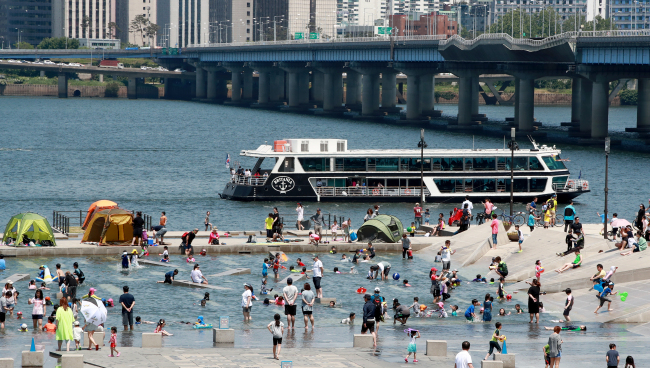Following weeks of yellow dust storms and high fine dust levels, South Korea is seeing a rise of ozone concentration levels in the air, which experts said are just as harmful as dust particles. High ozone concentration occurs when the temperature is high.
According to the Korea Meteorological Administration, a daytime high in Seoul on Sunday reached 28 degree Celsius, a summer heat normally expected at around mid-July to August. Daytime highs reached 29 degrees Celsius in Daejeon and Gwangju, and 30 degrees Celsius in Gangneung and Daegu.
According to the Korea Meteorological Administration, a daytime high in Seoul on Sunday reached 28 degree Celsius, a summer heat normally expected at around mid-July to August. Daytime highs reached 29 degrees Celsius in Daejeon and Gwangju, and 30 degrees Celsius in Gangneung and Daegu.

The KMA said daytime highs will hover around 30 degree Celsius across the nation until Tuesday.
With the mercury rising, the ozone concentration and ultraviolet index are likely to rise as well, according to a local weather forecast agency K-weather.
As of Sunday afternoon, ozone concentration levels were “bad” in metropolitan areas, inculding Gyeonggi, Gangwon, Chungcheong, and Jeolla Provinces.
Hot and dry summer weather normally intensifies ozone problems as sunlight reacts with emissions from cars, trucks and other sources to create ozone, the main ingredient in smog, experts say.
Experts warn that breathing ozone can trigger health problems such as chest pain, coughing and throat irritation. Children, older adults and those already suffering respiratory problems are advised to take extra precautions when the ozone concentration level is high.
“We are still experiencing a somewhat still bad quality of air after the country’s worst fine dust earlier this year, but I guess it is not the time to take masks off outside yet, with high ozone concentration problem to peak this summer,” said 31-year-old mother living in Suwon.
South Korea’s ozone concentration figures were seen worsening over the recent decades.
The ozone concentration went up from 66 micrograms per cubic meter in 1990 to 68 micrograms in 2015. The OECD average fell slightly from 61 to 60 micrograms during the same period.
Weather forecast encouraged citizens to avoid outdoor activities and to put on sun screen for protection during the daytime when ozone concentration is at its peak.
Skies will be relatively clear until Wednesday when sporadic rainfall is expected in parts of the country, reducing the temperature temporarily, the weather forecast said.
By Kim Da-sol (ddd@heraldcorp.com)



![[Exclusive] Korean military set to ban iPhones over 'security' concerns](http://res.heraldm.com/phpwas/restmb_idxmake.php?idx=644&simg=/content/image/2024/04/23/20240423050599_0.jpg&u=20240423183955)

![[Graphic News] 77% of young Koreans still financially dependent](http://res.heraldm.com/phpwas/restmb_idxmake.php?idx=644&simg=/content/image/2024/04/22/20240422050762_0.gif&u=)



![[Pressure points] Leggings in public: Fashion statement or social faux pas?](http://res.heraldm.com/phpwas/restmb_idxmake.php?idx=644&simg=/content/image/2024/04/23/20240423050669_0.jpg&u=)










